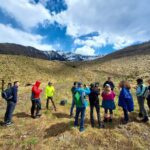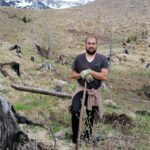Foundation Conservation Carpathia in partnership with the Carpathia Forestry Association began the reforestation program in the Făgăraș Mountains in areas destroyed in the past by extensive logging. The proposed target for spring 2022 is 100 ha, 435,000 seedlings planted in four ecological reconstruction areas: Groapele (affected both by non-compliant felling and by arson), Dobroneagu, Valea Dâmboviței and Lerești.
With financial support from the European Commission, within the project ‘Creating a wilderness area in the southern Carpathian Mountains, Romania – LIFE18 NAT/RO/001082’, Conservation Carpathia is restoring forests affected by clear-cutting or accidental felling by planting 435,000 spruce, beech and fir seedlings. The native natural species of seedlings come from Carpathia’s nurseries or are purchased from specialist producers in the area.
This spring’s reforestation sites include: 60 ha in the Groapele area, 25 ha in the Dobroneagu area, 8 ha in the Dâmboviței Valley and 7 ha in Lerești. To restore the riparian galleries along the Doamnei Valley, the team from Conservation Carpathia planted 750 seedlings of alder, an important species for stabilising the banks.
“Perhaps it’s harder to understand this specialist term we keep using – ecological restoration. Why don’t we just say reforestation,” says Mihai Zotta, conservation director of FCC. “Because there’s a lot more activity behind a new forest than the actual planting. When the organisation has bought a mistake of the past, an area where the forest was cut down 10-15 years ago and where the former owners did not meet the legislative requirement of planting within two years of felling, that is where we start a large process that involves several steps. At Groapele we initially carried out an inventory of natural regeneration by setting up more than 200 sample squares, which showed us what natural regeneration exists on the land, which species and in what proportions. On the basis of this inventory, we have determined which species, in what proportions and with what quantities of seedlings we need to intervene in order to fully restore the area. For the first time, we are also trying to take into account and predict the effects of climate change, such as the tendency of forest species to move upstream. We also inventoried the main areas of erosion on former logging roads where tractors dragged heavy logs. We’re talking about gullies ranging from 0.7 m to 5 m deep – and these mountain wounds need to be repaired, covered and replanted. We have nine nurseries and two greenhouses, and growing seedlings under natural conditions, without chemicals, in conditions that simulate their future life, is not easy. After the actual planting, every autumn we cut the grass around the small trees to ensure their unhampered growth and survival through the winter. That there was no balance in the past is clear to us all, but how we continue is the key to our future and that of generations to come.”
The seven years of a new forest
If we are to think mathematically, a new forest, from the seed stage until it is strong enough to stand on its own, needs care and attention for a minimum of seven years. Two to three years for growing saplings and another four to five years of care in the mountains, post planting.
Without active support, these areas return to their natural state of equilibrium with difficulty. Ecological restoration actions facilitate or mimic natural processes as far as possible and need to take future climate change into account. But restoring the whole ecosystem after a major imbalance is impossible.
Conservation Carpathia does not just plant any trees, which might be the best short-term economic solution, but creates a new natural forest, more resistant to the impact of climate change and pest attacks. In 10 years of ecological reconstruction Conservation Carpathia has planted beech, spruce, fir, alder, ash, elm, sycamore and yew and will continue with juniper, mountain pine and arolla pine as part of the LIFE Carpathia project.
About the project
The Conservation Carpathia project is unique in Romania and represents one of the most important forest conservation initiatives in Europe. From 2009 until today, the project has saved 26,900 hectares of forests and alpine meadows in the southeastern Southern Carpathians from logging and has restored 1,157 hectares of forest by planting more than 3 million seedlings.









